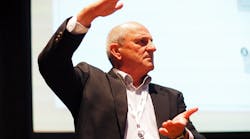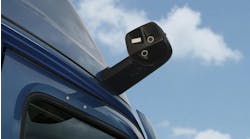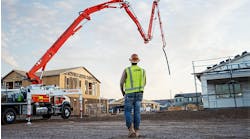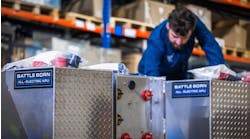Fleets looking to optimize their maintenance programs can take a page from a longtime industry veteran's book: "Steal shamelessly and give graciously." That's a sort of mantra Master Fleet LLC President Larry Chaplin offers from his decades' worth of experience on how to cut out waste, increase productivity and ultimately save money in maintaining a fleet.
"These feet have walked through a lot of shops," he says. "I've yet to go through a shop where I don't see an idea that I steal — and I always try to give more than I take."
Chaplin spent years working in maintenance for trucking powerhouse Schneider and for the nation, too, via the U.S. Army, where he says he "maintained vehicles in places you don't want to vacation." Chaplin's experience dates back to his high school days, when he worked part-time in a shop and stuck with the maintenance gig to put himself through college.
He recalls his work at Schneider — a tenure that spanned 21 years — and how the company cut its maintenance costs about in half during that time from just under $0.14/mi. to just under $0.07/mi. for a fleet that upon his departure included some 13,000 tractors and 30,000 trailers.
"No, we didn't do it with newer trucks," Chaplin notes. "We still had a seven-year trade cycle on power units and a 10-year trade cycle on trailers. We did it through all these ideas." He shared some of those in a presentation at TMW Systems' Transforum conference in Orlando, FL.
As far as the "stealing" and "giving" suggestions, Chaplin says, "I look at it this way: You can't live long enough to make all the mistakes that everybody's made in this business; you can't live long enough to learn all the things you need to learn.
"So steal shamelessly, and the reason I say give graciously is because we all need help."
To start, Chaplin says to approach fleet maintenance with three directives in mind: Define, streamline and eliminate. He attributes the methodology to some of the late author, engineer and management consultant W. Edwards Deming's teachings on quality.
"'Define' is one of the biggest things you're going to do if you're in charge of maintenance," says Chaplin. "At the end of the day, the buck stops at your desk to define the work — your technicians, your vendors, your drivers, everyone needs to know what you've defined as your company's policies on maintenance."
"Once you're defined the work, you need to work to streamline it: faster, better, cheaper, right?" he continues. Through things like technician training and how the maintenance shop is used, Chaplin contends, "you have to take every one of probably 1,000 processes that are involved in maintenance and you need to streamline them. If you cut 10 minutes, 15 minutes, 20 minutes, half an hour out of a job, multiply that across your enterprise and it's a lot of money."
And then, Chaplin says, comes eliminating — as in, cut out as many as possible of your trucks' unplanned trips to the shop, and causes thereof. "Why try to be good at something that you shouldn't be doing to begin with?" he quips. "What I want to do when I eliminate is look at any cause that led me to expend parts and labor or caused a breakdown.
"I want to know what the root cause of a breakdown is — was it the driver that needs training? Is it the mechanic? Is it my vendor shops? Is it a spec that I'm using? Is it a component? What's keeping that thing from being long-term dependable?"
Chaplin went on to suggest a number of steps fleets can take to optimize their maintenance performance, providing a roadmap to eliminating avoidable costs.
Part One
1. Address your PM process. When it comes to saving money on maintenance, Chaplin says fleets need to focus on their preventive maintenance, or PM, programs.
"Here's the way I feel about it: If you haven't got a PM process, you haven't got a maintenance program. To me, it's like the Christmas tree that all the other ornaments hang on — and if you don't have a tree, you've just got a bunch of junk on the floor," he says.
"The PM process ought to be the most revered thing in your system," Chaplin adds. "You ought to think, 'If I can get a good PM [program] with good, qualified techs and I'm doing it with the right checklist, I expect that truck to run out of the shop and not come back in until the next PM visit.'
"There's a lot of defining in that, and that's your job. You have to look at your own situation — how much idle do you have, [auxiliary power units], what kind of utilization, some oil analysis, that kind of thing — and you have to define that."
2. Set up PM items thoughtfully. Chaplin suggests cutting out as many unnecessary steps for technicians as possible, drawing an analogy to health care. "I like to see shops where I go in and they have a PM bag and everything that the mechanic needs is there. It's like when you go to a doctor's office or clinic — you see [nurses and physician assistants] and everybody fixing everything up so the doctor just goes from one to one to one to one," he says.
"That highest-paid technician of yours, you want him hardly even moving. You want all your oils, all your lubes, your [diesel exhaust fluid], your window wash, everything that he needs to do a PM — even the tools.
"One of the cheapest things you can do is just buy all the tools you need to do the PM. Whether you put them on a chain or whatever you do, don't have your guy going back and forth to his box."
3. Create centers of excellence. Chaplin recalls his days at Schneider, where he says shops would tackle the highest problem maintenance costs in setting best practices.
"We used to do analysis on the highest frequency and highest cost jobs, and then we'd do a center of excellence," he says. "You take one process and you get your best technicians — maybe even bring in someone from [your company's OEMs and suppliers] — then you get the best training, the best tools, the best parts, the best bay setup and everything else so that that job can't be done better by anybody for quality and time.
"Once you detail what that is, then you audit it to make sure everybody's doing it that way."
Part Two
4. Make it a competition. Also hearkening back to Schneider, Chaplin takes the centers of excellence discussion further and says fleets can create competition among their top technicians.
"We even had a PM Olympics. No kidding — we had all our shops compete. We'd rig tractors so we knew the five or six things they should find that were wrong, then we had teams go in there and do the PM," he says. "We'd measure their time, we'd measure the quality, we'd measure how they wrote it up — the whole enchilada — and we'd score them."
The elaborate competition featured regional winners and finals, according to Chaplin, with medals handed out at the end by the late trucking legend Donald J. Schneider.
"Your mechanics are just like the rest of us. They want to be competitive and they want to be recognized for a good job. In return, we ask that they do their job the best possible way we know how, every single time repetitively," Chaplin notes.
5. Cut out "frequencies." With such a central focus on the PM program, not surprisingly, Chaplin suggests that fleets also be starkly aware of — and drill down on — shop visits that aren't part of the program. "A 'frequency' is any time that truck is coming into the shop and it's not a PM. We measure it when we do an audit on a shop, and we're going to find out what's the root cause and why it had to come in there," he explains.
"You're going to define what work can be done between PM [intervals]. We want to get the thing done with a PM so good that that tractor doesn't have to come in," he says.
"I don't know how you grocery shop, but I'll tell you this: I don't drive to the grocery store, get a loaf of bread, drive back the next day and get some cheese, drive back the next day and get some mustard. What do we do? We make a list and go to the grocery store one dang time.
"We organize it and we get it all done; that's what your PM is," Chaplin adds. "We want to reduce the work we do between PMs, and we want to define what work we'll do over the road at vendor shops."
6. Classify trickles and gushers. Also in line with defining maintenance work, Chaplin says shop technicians should know the company's practices regarding leaky parts.
"Weeping, seeping, leaking — class 1, class 2, class 3 — all your people ought to be trained what your stances are on when you replace shocks, when you replace seals. Which of those criteria are you using, and do you audit it?" he asks.
"Because if I come to your shop, we're going to go out in the trash bin and we're going to look. It's one thing to say what you're doing, and it's another thing to audit it and see, 'Is that really what's in the trash bin?'"
Part Three
7. Don't open what you don't have to. Like leaks, Chaplin says fleets must set rules for when technicians open up parts of the truck like the air cleaner or brake systems.
"You've got to define that for brakes, drums, air filters and so on. You don't want the guy opening that up (e.g., the air cleaner) and probably introducing dirt, or worse yet, rolling the gasket or putting dirt in the gasket, and now you've got a bigger problem than when the truck came in," he notes. "Just do an air restriction test, and that's the only time you open it up is if it fails.
"Make sure when you're doing your PMs that you have all your independent [system] PMs figured out, too. You're going to have that for your diesel particulate filters, for your rear ends, your transmissions — you're going to do the same type of analysis for everything and set those up."
8. Make "go/no go" gauges. "A good standardization method is go-no go gauges," Chaplin says, displaying a diagram of a keychain tool one of his shops designed with a number of quick measurements on it, removing the need for maintenance techs to have to get a variety of tools from the toolbox.
"We just mass-produced the thing. We took away the mechanics having to go get something, and we also standardized the process," he explains. The tool included particular measurements for drive and trailer tires, steer tires, windshield cracks and brake linings.
"You just stick this in, apply the brakes, and if you can pull it out, the brakes are good. If you can't pull it out, well, it's under the thickness and you need to replace [the linings]," Chaplin says. Such go/no go gauges, Chaplin adds, "take all that measurement and all that guesswork out of it. When people say, 'I've got that and I've already told my mechanics that,' I say, 'I'm going to go out in your trash bin and I'm going to measure your brake thickness.' You'd be surprised how much lining is being thrown away."
9. Analyze maintenance trends. Beyond setting a shop's maintenance procedures and limits, Chaplin says fleets can learn a good deal with some analysis of "frequency" visits outside of the PM schedule.
"Cost stances are defining the work, but it's up to you to do it," he notes, adding that in consulting work, his company examines a sampling of maintenance data to gauge unscheduled visit causes. "We take a one-year sample — we go in and take 30 random units of your fleet and look at every [repair order, or RO] that you have in there to see which ones are PMs, which ones are frequency.
"One of the things you're going to see when you look at this is root causes. You're going to see frequency [visits] by driver; you're going to see frequency by unit; you're going to see frequency by types of unit. Was it a Freightliner, Kenworth, Peterbilt, whatever? There's a lot of trend analysis you can do."
Part Four
10. Use diagnostic checklists. "You ought to have standard processes you can take and just list out — if you have a standard database — for all your jobs, and you're going to be able to see which ones are highest cost, which ones are the most frequent and start attacking those and start building [standard operating procedures, or SOPs] and decision trees around them," Chaplin says.
"You've seen a lot of good ones where it starts off, 'Do this first; if it does this, do this. If it does this, do this.' Those are the kinds of things I'm talking about," he continues. "Make sure you have good diagnostic checklists. We've done a lot with air conditioning and electrical — those are the two biggest holes that you can dump a lot of money into, especially when people don't know what they're doing and are guessing.
"They're going to change this, they're going to change that, they'll see if it works and everything else. Electrical and air conditioning are two examples where if you put together a good checklist, you'll see a delta in your costs."
11. Narrow the bell curve. "Everything in the world that's a process has a bell-shaped curve. PMs — time to change a clutch, time to do a brake job per axle or per wheel, time to change lubes — every job you have has a standard deviation," Chaplin notes.
"There are some people that really can beat the productivity [standard repair times, or SRTs] — they're the As, and here are the Fs" he says, pointing toward either end of a bell curve diagram. "That's what happens when you standardize a process: get it under a center of excellence and standardize it, and when you get done, what you're going to see is the variance from the worst guy to the best guy is pretty tight.
"Do this in your shop with every process," he adds. "Then you start engineering it to save a half hour here, one-tenth of an hour there with a tool, with some training, maybe by removing a step. You're going to take all that randomness and make a step-level change."
The key, according to Chaplin, is to find and use the best method for any given process in the shop. "A lot of mechanics like to have the theory in their head that, 'Hey, everybody's got their own way.' Well, you get 60 different mechanics doing something 60 different ways, and I can tell you one thing: You've got one guy doing it the best way, and you've got 59 people doing it some sub-optimal way."
12. Keep on sharing. Chaplin encourages fleets to check out Master Fleet's "huddle" page at www.MasterFleet.com/huddle, a sort of online community the company is fostering to share and comment on ideas like the ones included in his presentation.
"The good news is, there's a hell of a lot more ways than this to attack and better your fleet maintenance performance," he says.
"It's free, and the purpose is just one thing: So we can all learn from each other. We put out a weekly newsletter — we just pick a topic — and then we ask for feedback on it and we ask people to get involved. We like to discuss things so everybody can share ideas."



